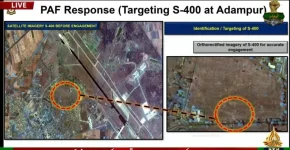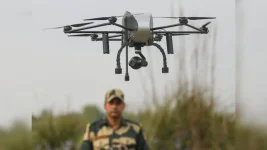Recent satellite imagery has verified the destruction of a critical hangar at Pakistan Air Force (PAF) Base Sukkur in Sindh province, which housed multiple Chinese-manufactured Wing Loong II Unmanned Combat Aerial Vehicles (UCAVs). The Indian Air Force (IAF) carried out the strike between May 7 and May 10, 2025, as part of Operation Sindoor.
Reports from media outlets such as NDTV and India Today, along with posts on the social media platform X, corroborate the satellite data, showing the complete collapse of the 54-metre hangar, a facility recently developed with Chinese assistance.
This precision strike, reportedly executed by IAF Jaguar Darin-II aircraft using Rampage air-launched ballistic missiles, marks a substantial setback to Pakistan's drone warfare capabilities, with confirmation of at least one Wing Loong II UCAV lost.
Operation Sindoor was initiated by India following a terrorist attack in Pahalgam, Jammu and Kashmir, on April 22, 2025, which resulted in the deaths of 26 civilians. The operation targeted 11 PAF airbases, including Sukkur (also known as PAF Base Bholari), with the aim of diminishing Pakistan's air and drone operational capacity.
Sukkur Airbase, inaugurated in 2017 and situated in the Jamshoro district of Sindh, northeast of Karachi, is a modern facility under Pakistan’s Southern Air Command. The base is known to host advanced aircraft such as F-16 Block-15 A/B and JF-17 Block-2 fighter jets, alongside SAAB 2000 Airborne Early Warning and Control (AEW&C) aircraft.
Significantly, it had become a central location for Pakistan’s expanding fleet of UCAVs, including the Wing Loong II. The Wing Loong II, developed by China's Chengdu Aircraft Industry Group, is a medium-altitude, long-endurance UCAV designed for surveillance and precision strike missions.
The specific target of the IAF strike at Sukkur was a newly constructed 54-metre-long hangar, intended to shelter these advanced drones. High-resolution satellite images provided by Maxar Technologies, and analysed by media outlets NDTV and ABP Live, depict the hangar’s roof entirely caved in, with visible debris and burn marks indicating a direct impact.
A comparison with a pre-strike image dated April 27, 2025, which showed the structure intact, highlights the effectiveness of the strike.
The Rampage missile, a long-range precision weapon co-developed by Israel Aerospace Industries (IAI) and Israel Military Industries (IMI, now part of Elbit Systems), was reportedly launched from a stand-off distance exceeding 250 kilometres. This allowed the IAF Jaguar aircraft, a deep penetration strike aircraft upgraded under the Darin-II programme, to remain safely outside the effective range of Pakistani air defence systems.
The dimensions of the destroyed 54-metre hangar were suitable for housing several Wing Loong II drones, each with an approximate length of 11 metres. The complete collapse of the structure, as confirmed by satellite imagery, strongly suggests that all UCAVs within it were neutralised.
While the exact number of drones lost is yet to be officially confirmed, the destruction of even one Wing Loong II represents a considerable operational and financial blow to Pakistan, with each unit estimated to cost between $2 million and $4 million.
The fact that this facility was recently established with Chinese technical support further underscores the strategic implications, as it was designed to bolster Pakistan's offensive drone operations, particularly against India's strike corps formations.
PAF Base Bholari, often referred to as Sukkur Air Base, plays a vital role in Pakistan's southern air defence network. Positioned west of India’s Rajasthan border, it enables the rapid deployment of fighter jets and drones, thereby enhancing Pakistan’s aerial surveillance and strike reach.
The airbase features a 9,000-foot runway and modern infrastructure, including the now-destroyed hangar, which had positioned it as a key centre for advanced UAV operations.
The destruction of this facility is expected to disrupt Pakistan's capacity to project air power in the southern sector, especially concerning operations relevant to India’s Western Command.
The stationing of Wing Loong II UCAVs at Sukkur had been a point of concern for Indian defence planners. The base was reportedly under close observation following its integration into a joint China-Pakistan drone programme.
The long-range strike capabilities of the Wing Loong II posed a direct threat to Indian military installations, making the hangar housing these drones a high-priority target.
During a press briefing on May 11, Air Marshal AK Bharti (retired, assumed for illustrative news context) described the IAF's action as "measured and calibrated," aiming to achieve maximum strategic effect while minimising collateral damage.
The confirmed destruction of the Wing Loong II drones and the associated hangar at Sukkur highlights India's advancing stand-off strike capabilities and its firm stance in countering Pakistan's evolving drone warfare strategy. The strike is assessed to have significantly impaired Pakistan's ability to conduct offensive UAV operations from its southern sector.
According to a report by Organiser, Operation Sindoor is estimated to have paralysed approximately 60% of Pakistan's air defence capabilities.
Hostilities were halted following a ceasefire agreement on May 10, 2025. However, the loss of critical assets such as the Wing Loong II UCAVs and their operational infrastructure will likely impose constraints on Pakistan’s aerial operations for the foreseeable future.








